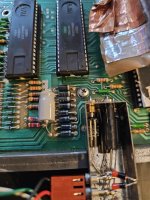daver2
10k Member
MK4027 DRAM requires +5V, +12V and -5V supplies. The +10V supply is for the custom ICs. This defines the voltages required from the regulators.
Correct, if you reverse the AC transformer windings it makes no difference (99.99% of the time) on a power supply. At least someone used their intelligence in ordering the connections on the connector. As a result, it should not matter in the slightest if the AC connector is reversed.
In general, a TI 7812 should be a direct replacement. Check the datasheets for the two regulators. Check the current rating and pinout. If these are the same, in general, you should be good to go.
Don't forget, if these devices are 35+ years old, the word "indestructible" doesn't actually apply anymore! Old semiconductors can have manufacturing issues over time. For example, IC pins rust the plastic encapsulation can let in water vapour over time, the epoxy used in the packaging can degrade and degrade/destroy the internal semiconductor, purple plague (look it up) can occur internally. All these issues kan 'kill' a device over time.
I would have said that a RIFA capacitor or a tantalum bead capacitor was "indestructible" (once it had passed its burn in process). You would disagree with that statement wouldn't you! But, if you look at the datasheets for the devices, they do not describe an end-of-life condition...
Indestructible voltage regulators are indestructible, until they destruct!
So, yes, a voltage regulator can self destruct...
Dave
Correct, if you reverse the AC transformer windings it makes no difference (99.99% of the time) on a power supply. At least someone used their intelligence in ordering the connections on the connector. As a result, it should not matter in the slightest if the AC connector is reversed.
In general, a TI 7812 should be a direct replacement. Check the datasheets for the two regulators. Check the current rating and pinout. If these are the same, in general, you should be good to go.
Don't forget, if these devices are 35+ years old, the word "indestructible" doesn't actually apply anymore! Old semiconductors can have manufacturing issues over time. For example, IC pins rust the plastic encapsulation can let in water vapour over time, the epoxy used in the packaging can degrade and degrade/destroy the internal semiconductor, purple plague (look it up) can occur internally. All these issues kan 'kill' a device over time.
I would have said that a RIFA capacitor or a tantalum bead capacitor was "indestructible" (once it had passed its burn in process). You would disagree with that statement wouldn't you! But, if you look at the datasheets for the devices, they do not describe an end-of-life condition...
Indestructible voltage regulators are indestructible, until they destruct!
So, yes, a voltage regulator can self destruct...
Dave


